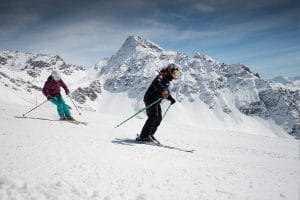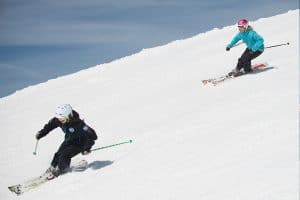By Julian Griffiths
Photos by Nick Reader
Many times throughout my career, I’ve heard mums tell me that they used to love skiing with their husbands, but post-kids have found themselves trailing behind the family, children accelerating ahead in ability while mum and sometimes dad become more and more fearful, losing confidence day after day. However, this issue is not just limited to mums; in any family or group where one person has fallen behind or started at a disadvantage, keeping up can be an experience terrifying enough to put you off for good.
Even for those who love to ski, a partner who doesn’t enjoy skiing with you can have a negative impact on your skiing experience.
My favourite client over the past two seasons has been a mature gentleman widower who has remarried an avid skier. Let’s call him Bob. We were paired up by a mutual friend who could see Bob was struggling to keep up and not enjoying his skiing.

Bob arrived, and I asked the usual questions.
Which runs have you skied?
He’d skied all the challenging, marked off-piste runs in Verbier. Quite impressive.
How long have you been skiing?
A few years after a 30-year gap.
Then we went skiing; experience taught me to start on a super easy run. As I eased into the first turn, I looked back, and Bob seemed ok. He rotated his feet, steering his skis towards the fall-line. Then suddenly, as his skis approached the fall-line, his shoulder rotated into the turn, hips followed and the skis, now virtually flat and with most of his weight on the inside ski, started to wobble. As much as he twisted his body, his skis only slightly turned, reluctantly and wobbling violently. Skis can be tricky like this. Turn the legs, you’re alright; turn the body, the skis don’t like it.
The same calamity occurred on the next turn. And the next. At each turn, Bob’s skis wobbled uncontrollably and only took him where he wanted to go in the most unhelpful and reluctant way they could: slowly. Skiing like this is no fun; the skier feels the speed getting away from them, like they have no control.
That Bob made it down some of the runs he’d skied was incredible.

Of course, Bob could feel that the skis didn’t want to turn, so did what came naturally: he rotated his body and hips more and more into each turn. This kind of rotation only makes it worse, flattening the skis and making the wobble turn into a shake.
Now, Bob’s a staunch bloke; he can handle himself and a bit of wobbling wasn’t going to put him off. But skiing like this is exhausting and it was taking its toll. What really struck me about his terrible technique was that he looked so uncomfortable doing it. It was difficult, inefficient, tiring and looked bad, but it had got him down some of the most terrifying slopes Verbier has to offer.
Bob’s not the sort of person to admit to being terrified halfway down the Vallon D’Abris. He’s a tough old coot. His problem was that his new wife, an awesome skier, had been dragging him down these difficult slopes. This experience was probably not much fun for either party; I’d been lucky to catch Bob before he gave up on skiing entirely.
Our first lesson was on an easy blue run. At the end of the session, I sat down with Bob and explained that his over-rotating was caused by his wife and friends taking him, for years, down slopes that were too steep.

While he was trying to get the turn over with as soon as possible, the proper technique is very different, much more subtle, and the only place for him to learn it was the flattest slope we could find.
Luckily, he agreed to give it a go.
For the remainder of the week, for two hours a day, we went to Verbier’s beginner slopes and carefully re-built Bob’s technique from the ground up. Bad habits take a lot of un-learning, but we progressed bit by bit. Bob started to enjoy a good turn and be very aware of a bad one.
Later that season Bob came back, and we did another week. This time we went a little higher up the mountain, more efficient now, and a little faster. Bob even admitted he was beginning to enjoy skiing.
Of course, this has taken a lot of patience. As an instructor, I’m pretty stoked to have someone skiing on the mountain with me who was on the cusp of giving it all up.

Bob’s wife is happy; we often finish our lessons at a restaurant on the mountain where they can have lunch together. Sometimes I’m invited to join, which is always a pleasure for any ski instructor, even the boss of the ski school. Bob’s confidence is mostly back. Sometimes there are setbacks; friends have taken him on a slope that’s too steep. If this happens, I can see the difference straight away in our next lesson.
Stick to easy pistes if you’re trying to build confidence. Places and slopes where you are comfortable. The steeper slopes only make things happen too quickly, with too much force.
Confidence is a tricky thing; many people offer fancy fear-reducing psychological treatments like neuro-linguistic programming (NLP) and hypnosis. However, I think this is pretty pointless unless you’re genuinely traumatised. Most people just need to feel confident doing turns. Then they feel safer going skiing. This safeness, this confidence, eventually leads to being able to ski faster.
In my experience, a bit of time spent going back to basics, remembering the things you learned when you started skiing, the right guidance and the right terrain is what it takes. The most important aspect for anyone who finds themselves out of their depth on skis is to go back to easy pistes and re-learn the necessary skills to tackle the slopes with ease.
Bob and I hopefully will ski together for many more years; I hope one day he will ski as fast as his wife. Already, last season she was genuinely impressed with his progress when she swooshed passed us one morning.
Julian Griffiths runs ES but also teaches. If you or someone you know would like to ski with Julian for a confidence-building series of lessons, please contact us to make a reservation.
